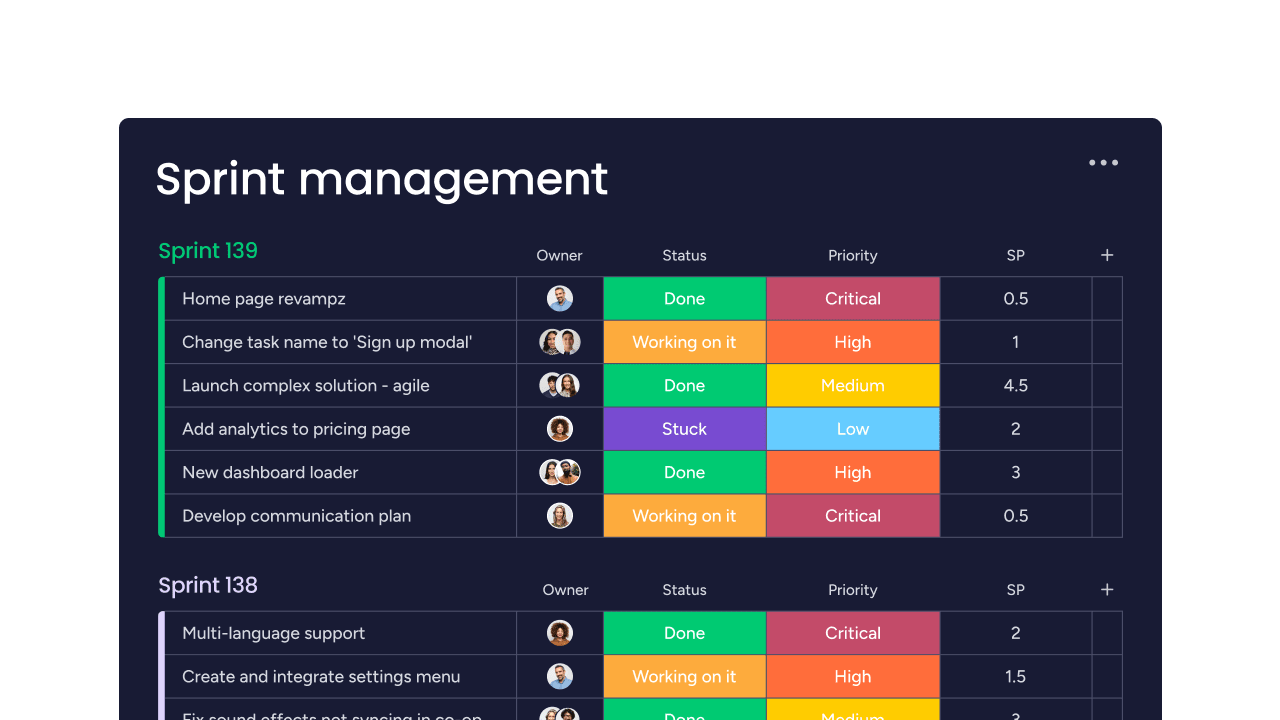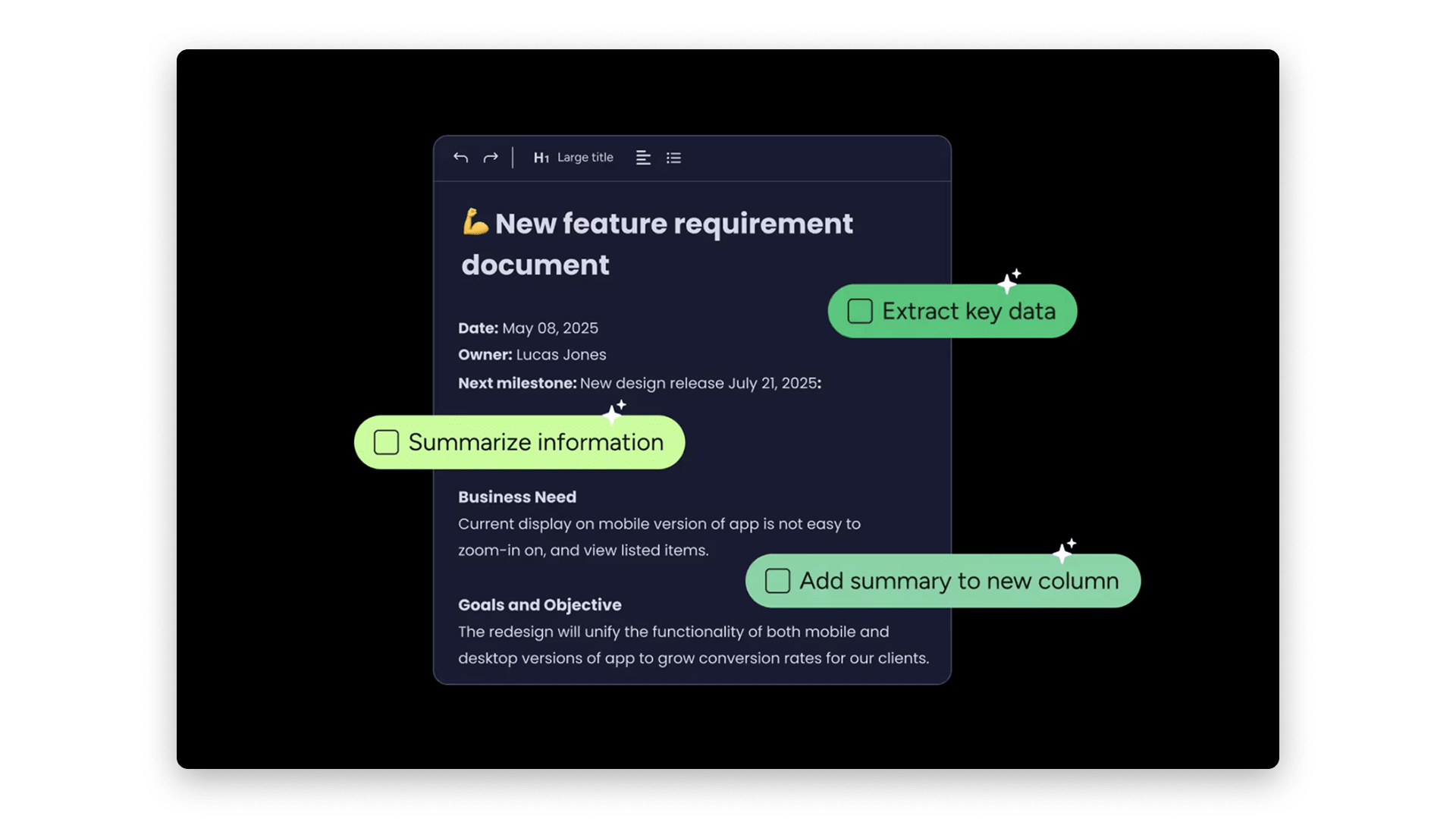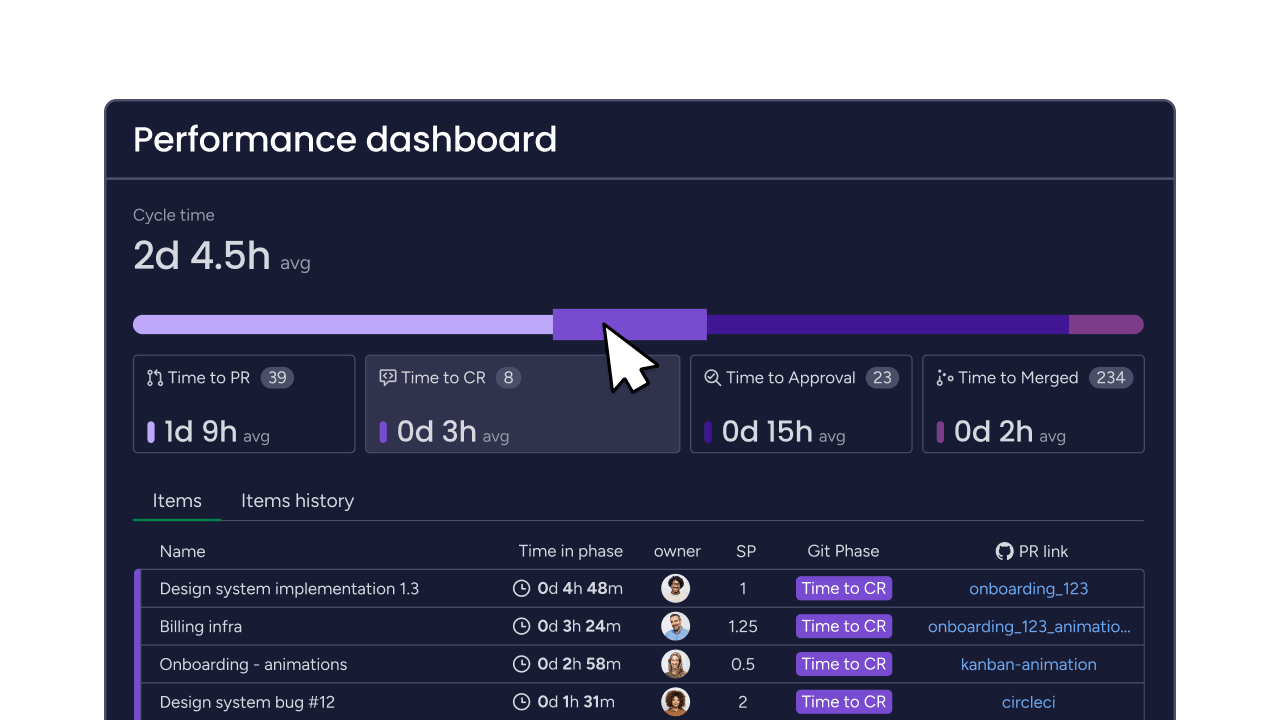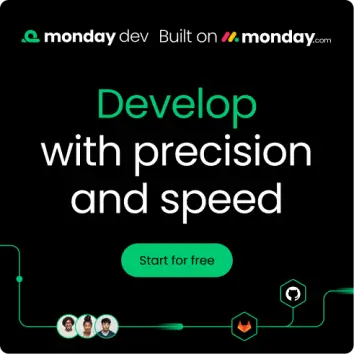Traditional software development is steady and deliberate. Which is fine, until it results in delays and missed opportunities as you wait to launch your digital product.
In contrast, Agile software development lifecycles are nimble and flexible, offering value with every iteration.
In this guide, we’ll explore the Agile software development lifecycle (SDLC) in more detail, highlighting its key benefits and sharing best practices for implementing it. As a bonus, we’ll also show you how to transform your Agile development process with monday dev.
Try monday devKey takeaways
- Agile SDLC breaks software development into flexible, iterative sprints, enabling teams to deliver value quickly while adapting to evolving customer needs and market shifts.
- The methodology follows 6 core phases: planning, development, testing, deployment, maintenance, and retirement — each designed for rapid feedback and improvement.
- Agile SDLC enhances customer satisfaction, facilitates problem detection, promotes team collaboration, and improves product versatility compared to traditional models, such as Waterfall.
- Popular Agile frameworks — including Scrum, Kanban, and SAFe — can all be managed and adapted using monday dev to centralize workflows and maximize team efficiency.
- Agile teams can scale faster and collaborate more effectively — from planning to product launch — with monday dev’s integrated AI tools, real-time dashboards, and workflow automations.
What is the Agile software development life cycle (SDLC)?
The Agile software development life cycle (SDLC) is an iterative and flexible framework for building software that prioritizes customer needs. Instead of delivering a finished product all at once, Agile breaks work into smaller, manageable cycles called sprints, each producing a functional piece of value that is delivered incrementally. Teams collaborate closely, review progress regularly, and quickly adapt based on feedback, ensuring the final product closely aligns with user expectations.
A typical sprint lasts between 2-4 weeks, allowing for rapid delivery, continuous testing, and frequent course correction. This approach reduces risk, boosts transparency, and encourages stakeholders to guide the product’s direction throughout the project. With every iteration, the Agile SDLC ensures teams deliver better solutions and faster results.
For example, in the first sprint, the development team may focus on creating a basic user interface and product mock-up, before adding further core functionality in the second, third, and fourth sprints. Each sprint creates space for stakeholders to give feedback and request changes throughout the process.
The 6 phases of the Agile software development life cycle (SDLC)
While the Agile software development life cycle is known for its fluidity, it still involves some core phases:
Phase 1: Planning
The planning (or concept) phase defines the project’s vision and goals. Create a product roadmap, research competitors, and prioritize the features you need for your project. This is also the time to estimate the costs and resources you require to complete everything.
Phase 2: Development
Teams hit the ground running in this stage, working together in sprints to create a product that meets the requirements set out in the planning stage. It’s not about perfection but about creating a foundation to build on.
Phase 3: Testing
Based on your product’s current version, you’ll commit to regular testing to ensure that each update functions as intended. You’ll document the results of each test and fix any bugs before proceeding to the next step.
Read more about Agile testing in our comprehensive guide.
Phase 4: Deployment
After plenty of back-and-forth during testing, you’ll reach the approval stage when you’re ready to release the product to market. In Agile cycles, conducting a soft launch or beta test with a pilot group is common before launching to a wider audience.
Phase 5: Maintenance
Few high-quality products launch without a hitch, so this stage centers around offering ongoing support and maintenance of the product, including bug fixes and updates to ensure it remains functional, secure, and relevant to customers’ needs.
Phase 6: Retirement
Every product has a shelf life, so this stage involves smoothly transferring your customers to a new, shiny product that better suits their needs. Your developers will roll back support on the existing product and finally discontinue and remove it from the market entirely.

"monday dev empowered us to optimize our GTM approach, resulting in faster, more dependable deliveries"
Steven Hamrell | Director of Product Management
"monday dev empowers us to manage the entire development process on one platform so we can speed up product delivery and improve customer satisfaction"
Mitchel Hudson | Head of Technology
"We're operating in an open, deep trusting, transparent environment with no silos of information. It's about completely opening access to everyone who needs it."
Alan Schmoll | Executive Vice President, Vistra PlatformCore Agile values and principles
The core Agile values and principles — as documented in the Agile Manifesto — underpin the Agile approach to software development.
The 4 Agile values
The 4 Agile values prioritize certain aspects over others to ensure development teams remain agile and responsive:
- Individuals and interactions over processes and tools.
- Working software over comprehensive documentation.
- Customer collaboration over contract negotiation.
- Responding to change over following a plan.
As the Manifesto states: “While there is value in the items on the right, we value the items on the left more.” In other words, while the right side is good, the left is even more valuable.
The 12 Agile principles
The 12 Agile principles reinforce and extend the Agile values of customer satisfaction, collaboration, adaptability, and continuous improvement.
- Deliver valuable software early and continuously to satisfy the customer.
- Welcome changing requirements, even late in development.
- Deliver working software frequently, in short cycles.
- Business people and developers must work together daily.
- Build projects around motivated people, give them support and trust.
- Face-to-face communication is the most efficient method.
- Working software is the primary measure of progress.
- Maintain a sustainable development pace indefinitely.
- Continuous attention to technical excellence and good design enhances agility.
- Simplicity — the art of maximizing the amount of work not done — is essential.
- The best architectures, requirements, and designs emerge from self-organizing teams.
- Reflect regularly and adjust team behavior for continual improvement.
Agile SDLC vs. traditional SDLC
To see how Agile compares to a traditional model, we’ve compared the key differences between Agile and Waterfall SDLC at a glance:
| Waterfall SDLC | Agile SDLC |
|---|---|
| Carefully planned first version | Speed and adaptability |
| Limited transparency | Full transparency between members |
| Top-down responsibility | Shared responsibility and ownership |
| Initial research and planning | Ongoing research, planning, and testing |
| Different teams in different stages | Ongoing collaboration |
| Focused on delivering full product | Iteration-focused |
4 key benefits of the Agile software development life cycle (SDLC)
The Agile software development life cycle has numerous selling points for developers:
1. Deliver products that truly meets customer needs
The Agile software development life cycle aims to create a product that meets customers’ needs — not the product you think they need, but the one they actually want and need. Regular feedback from customers and focus groups shapes the product direction, providing new features or adjustments that match customers’ preferences and buying behaviors.
2. Adapt quickly to market shifts and new opportunities
The Agile approach allows you to pivot if the market or customer demand changes unexpectedly. Perhaps you planned to build a product with a specific USP, but during the testing phase, you uncover something that could extend its appeal to an entirely new market. Unlike traditional product management, Agile methods accommodate change and allow for rapid adjustments.
3. Catch and resolve issues early in development
Traditional product development cycles involve several rigid stages that aren’t easy to roll back if obstacles arise. Agile is the polar opposite; it invites feedback so you can catch and fix bugs quickly before they snowball into bigger issues that are more difficult to remedy.
4. Build stronger collaboration and shared ownership
Agile is all about conversation. Frequent check-ins keep the project moving and everyone accountable for their part of the puzzle. In contrast, traditional methods are based more on handovers from one siloed department to the next. The research team might complete their set of tasks, then hand over to the design team, and then the development team.
Popular Agile SDLC frameworks
The most popular Agile SDLC frameworks include Scrum, Kanban, Scrumban, and the Scaled Agile Framework (SAFe). Each offers a unique approach to iterative development, teamwork, and project delivery — and monday dev supports them all seamlessly.
Scrum
Scrum organizes work into time-boxed sprints (typically 1–4 weeks), emphasizing cross-functional teams, defined roles (product owner, scrum master, development team), and continuous delivery of working software. Scrum focuses on transparency, inspection, and adaptation at regular intervals.
Kanban
Kanban provides a visual system for managing work items through columns that represent various stages of a workflow. It promotes continuous delivery, flexibility, and focuses on limiting work in progress to improve flow and reduce bottlenecks. Kanban is especially suitable for teams that need to manage evolving priorities and workflows without fixed sprints.
Scrumban
Scrumban is a hybrid approach that combines elements of Scrum and Kanban. It allows teams to gain the process definition from Scrum and the flow-based visual management of Kanban. Scrumban is ideal for teams transitioning between methodologies or seeking to increase their process agility.
Scaled Agile Framework (SAFe)
SAFe is designed for enterprises running multiple Agile teams and projects simultaneously. It brings structure, alignment, and scalability by integrating Lean and Agile principles at every organizational level. SAFe supports large-scale development, coordinating cross-team dependencies and synchronizing delivery.
Other frameworks
Other notable Agile frameworks include:
- Lean, Extreme Programming (XP)
- Feature-Driven Development (FDD)
- Adaptive Software Development (ASD)
- Adaptive Project Framework (APF)
The Agile iteration process
Within each phase of the Agile SDLC, teams follow a repeating iteration (or sprint) cycle — a structured loop of planning, building, testing, and reviewing that drives continuous improvement and faster delivery.
Each iteration follows 5 key steps:
- Planning: Teams collaborate with stakeholders to define what will be included in the upcoming iteration, breaking down the highest-priority tasks into actionable user stories and estimating the effort required to complete them. Objectives are set based on user requirements and business priorities.
- Execution: Development happens throughout a short, time-boxed cycle (typically 1–4 weeks). Daily stand-up meetings ensure alignment, address blockers, and provide progress updates to maintain high momentum.
- Continuous testing: Testing is integrated throughout the iteration to catch issues early and maintain quality. This includes automated, manual, and user acceptance testing as needed.
- Review: At the end of the iteration, the team demonstrates working software to stakeholders, who provide feedback. This ensures the increment meets requirements and is ready for use or further development.
- Retrospective: Teams hold a retrospective to reflect on successes, challenges, and lessons learned. Process and workflow improvements are identified and implemented in the next iteration to foster continuous enhancement.
Best practices for implementing Agile SDLC
Here are some key best practices for successfully implementing the Agile software development life cycle (SDLC).
Secure buy-in from all stakeholders
Ensure all team members — developers, managers, clients, and key stakeholders — fully support the Agile mindset and are committed to iterative delivery and frequent collaboration. This foundational buy-in fosters trust, open communication, and enables smooth implementation across teams.
Choose the right Agile framework
Select an Agile framework — such as Scrum, Kanban, Scrumban, or SAFe — tailored to your team’s size, project complexity, and workflow needs. Start with one framework and remain flexible, adjusting as the organization and project evolve.
Maintain an organized and prioritized product backlog
Collaborate closely with product owners and stakeholders to create and refine a dynamic product backlog of user stories, features, and tasks. Regular grooming and re-prioritization ensure the team always works on the highest-value items — responding rapidly to changing requirements.
Emphasize continuous feedback, testing, and adaptation
Integrate continuous testing within each iteration, collect user and stakeholder feedback frequently, and run sprint reviews and retrospectives at the end of every cycle. This enables early issue detection, process improvement, and incrementally enhanced product quality.
Leverage automation and AI for visibility and efficiency
Integrate project management tools and AI solutions — such as monday dev — to track progress, manage dependencies, and automate repetitive tasks for more accurate planning, risk forecasting, and resource allocation. This ensures clarity, proactive issue management, and scalable Agile best practices as teams and projects grow.
When to use the Agile software development life cycle (SDLC)
The Agile software development life cycle (SDLC) is best suited for projects with evolving requirements, collaborative cross-functional teams, and delivery of fast, high-quality updates.
On the other hand, Agile SDLC may not be the best fit for small, well-defined, or highly regulated projects where requirements are fixed from the outset and little adaptation is required. For maximum success, all team members, including stakeholders, must adopt the Agile mindset and be prepared for regular collaboration and rapid change.
Here are 6 scenarios suited to the Agile SDLC:
- Evolving requirements: Agile is ideal when project goals, user needs, or market demands may change as the project progresses. The iterative process accommodates ongoing input and adaptation, allowing for continuous improvement.
- Continuous feedback is essential: Agile’s short cycles and regular reviews enable frequent customer or stakeholder feedback. This ensures the end product closely matches user needs and expectations.
- Collaboration across teams: Agile fosters strong communication between developers, business stakeholders, and users, helping keep everyone aligned and engaged throughout the project.
- Fast-paced environments: When early delivery of a working product is critical, Agile’s incremental releases enable teams to get software into users’ hands faster, with each iteration building upon the last.
- Complex, large-scale projects: Agile is also suited for distributed teams and large projects that benefit from frequent check-ins and visibility across multiple stakeholders or departments.
- High uncertainty and innovation: For projects that are breaking new ground or require creative problem-solving, Agile’s flexibility makes it easier to pivot and test solutions quickly.
What about the challenges of Agile SDLC?
Although Agile offers flexibility and faster delivery, it’s not without challenges. Teams often struggle with maintaining documentation, managing scope creep, or aligning distributed stakeholders. Without clear communication and the right tools, iterations can become chaotic instead of productive — which is where centralized platforms like monday dev make all the difference.
monday dev Testimonials

"monday dev empowered us to optimize our GTM approach, resulting in faster, more dependable deliveries"
Steven Hamrell | Director of Product Management
"monday dev empowers us to manage the entire development process on one platform so we can speed up product delivery and improve customer satisfaction"
Mitchel Hudson | Head of Technology
"We're operating in an open, deep trusting, transparent environment with no silos of information. It's about completely opening access to everyone who needs it."
Alan Schmoll | Executive Vice President, Vistra PlatformTransform your Agile development process with monday dev
Agile SDLC is far from static. Your team and project must continuously adapt to your customers’ needs as you move from iteration to production. That’s why you need a central, organized workspace to house everything from your product roadmap and sprint goals to your backlog and stakeholder communications.
Built on monday.com Work OS, monday dev is purpose-built to help product and engineering teams take full ownership of their Agile workflows — from sprint planning to product release. Here are 5 standout features for Agile SDLC success:
Full workflow flexibility
Design and adapt workflows to fit any Agile framework — Scrum, Kanban, hybrid, or custom. With monday dev, each team can build their approach, so the process never becomes a blocker.

Real-time collaboration and alignment
Break silos with transparent, real-time collaboration across development, product, and leadership. Everyone sees priorities, progress, and blockers at a glance, keeping teams and stakeholders aligned on every sprint and release.
AI-enhanced planning and execution
Leverage integrated AI Blocks for backlog management, sentiment analysis, risk detection, summarization, and task assignment. With monday dev’s built-in AI, you can automate repetitive tasks, increase accuracy, and anticipate team requirements for continuous improvement.

Advanced project and portfolio visibility
Managers and team leads gain instant access to dashboards that display sprint status, resource allocation, bottlenecks, and goals across multiple teams or projects — without slowing down execution or micromanaging.
End-to-end software development lifecycle management
Connect planning, development, QA, and deployment in one platform, eliminating manual data transfers and context-switching. With monday dev, Agile teams can centralize documentation, automation, and reporting, reducing errors and boosting delivery speed.

These features help Agile teams scale, innovate, and deliver value faster in any environment, while staying connected — from feature ideation to launch. Try monday dev free for 14 days to see how you can transform your Agile development process.
Try monday devFAQs
How does the software development lifecycle work with Agile sprints?
The SDLC, when run with Agile sprints, becomes cyclical and iterative. Each sprint incorporates feedback, allowing teams to adapt quickly and improve the product incrementally rather than waiting for a single result.
Is SDLC Waterfall or Agile?
SDLC refers to the overall process of software creation and maintenance. You can follow a Waterfall (sequential), Agile (iterative), or hybrid approach, depending on project needs, team preferences, and desired outcomes.
How long should an Agile sprint last?
An Agile sprint usually spans 1–4 weeks, depending on team size, project complexity, and customer needs. Most teams favor sprints of 2 weeks to balance steady progress with rapid delivery and frequent feedback. But you must find the sweet spot that allows you to deliver quality products efficiently.
How long does the Agile SDLC take to implement?
Agile SDLC implementation time varies, but most teams can see results within a few iterations — typically a few weeks to a few months. The timeline depends on team experience, product complexity, and stakeholder engagement. Tools like monday dev can accelerate onboarding and coordination across teams.
Can Agile SDLC work for large enterprise software projects?
Yes, Agile SDLC is highly effective for large enterprises. Frameworks like SAFe scale Agile practices across multiple teams, enabling coordination and fast delivery of complex, cross-department projects. Platforms like monday dev offer features for managing projects at scale with robust workflow and visibility capabilities.
What are the most common challenges when implementing Agile SDLC?
Common challenges when implementing Agile SDLC include resistance to change, unclear requirements, lack of stakeholder buy-in, team misalignment, and inconsistent feedback. Overcoming them requires strong leadership, regular communication, continuous training, and the use of transparent, collaborative platforms like monday dev for centralized tracking.
How do you measure success in the Agile software development life cycle?
You can measure Agile SDLC success by the timely delivery of working software, customer satisfaction, product quality, and the team’s ability to respond to changing requirements. Metrics include sprint velocity, lead time, defect rates, and user feedback. With monday dev, you can easily monitor these results in customizable dashboards.
Is Agile SDLC suitable for all types of software development projects?
Agile SDLC is best for projects with dynamic requirements, collaborative teams, and a focus on rapid delivery. It may not be suitable for projects with fixed, regulatory-driven specifications or limited team involvement. You should evaluate each project to ensure its requirements align with Agile's flexibility and adaptability.
What is the difference between Agile SDLC and DevOps?
Agile SDLC focuses on iterative software development, frequent releases, and customer collaboration. DevOps is a broader culture that combines development and IT operations to automate deployment, facilitate smooth collaboration, and ensure continuous delivery. Both can work together, with many organizations using Agile for development and DevOps for release and infrastructure management.
 Try monday dev
Try monday dev 


